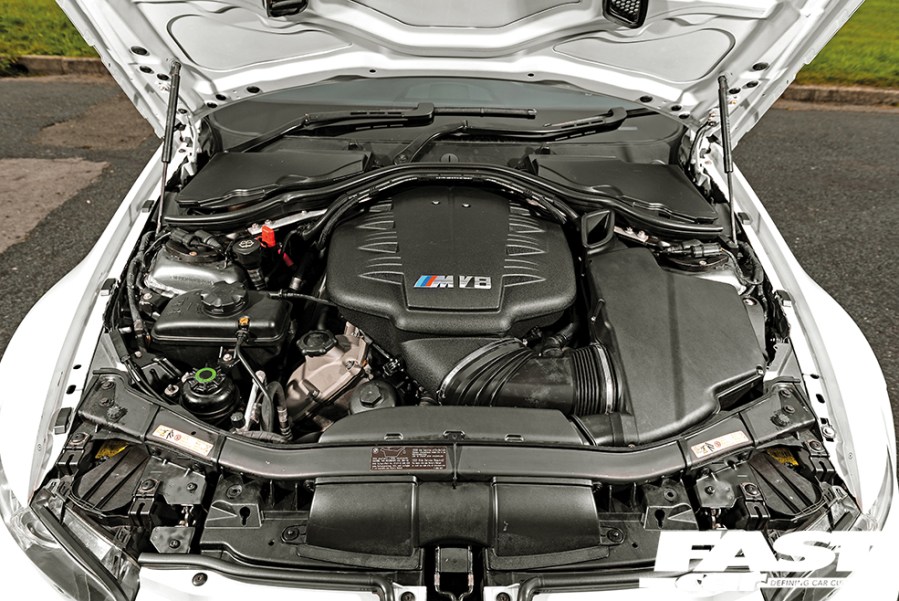Every generation of BMW M3 has been powered by incredible engines, each one a technical masterpiece and an absolute powerhouse of performance for its time, and here we celebrate all of them.
Guide from Performance BMW magazine.
BMW M3 Engines
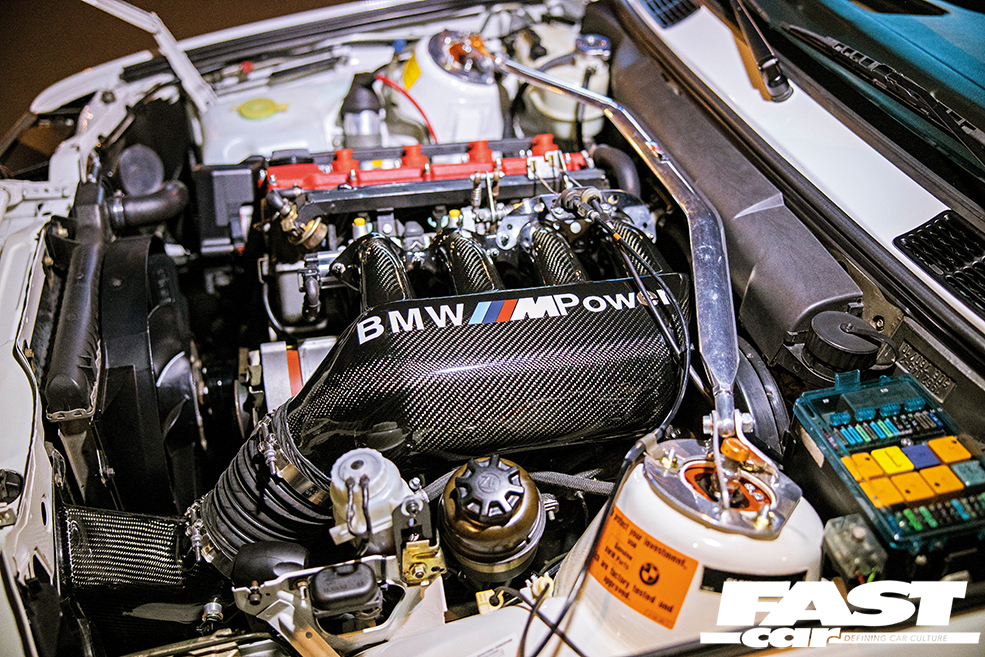
S14
History
The story of BMW M3 engines starts with the famous E30 M3’s motor, the S14. The S14’s bottom end is based around the tried-and-tested M10, though taken out to 2.3 litres thanks to a slight increase in bore and stroke. It is bolted to what is often referred to as an M88 head with two cylinders chopped off – that means four valves per cylinder, double-overhead cams and individual throttle bodies. Designed by legendary engineer Paul Rosche, the S14 was made to do one thing and one thing only – make the E30 M3 win DTM races. Those bore and stroke dimensions had been chosen to give the S14 the capability for stratospheric revs and strong power and its character is quite unlike almost every other BMW engine. And, despite several measures to make it happy on the road, there’s no hiding the fact that it’s a rough and ready race engine through and through.
The smallest S14 appeared in the E30 320iS, built exclusively for the Italian and Portuguese markets as the M3 wasn’t available in those countries and so the 192hp 320iS was the next best thing. The M3’s 2.3-litre S14 was initially offered with 200hp – the Evo 1 (introduced in February 1987) had the same figure although featured a revised cylinder head, distinguishable by an ‘E’ cast into the head, just below the fourth throttle port. The Evo II was introduced in March 1988 and with it, the S14 received several changes – including an increase in compression ratio, which resulted in 220hp. Distinguishable by its white rocker cover with M-coloured stripes, this was the ultimate evolution of the 2.3-litre production engine. The reason for this was that in 1990 the M3 Sport Evolution was revealed and with it came an enlarged S14, now sporting a set of red HT leads and displacing 2467cc, achieved by enlarging the bore and fitting a longer-stroke crankshaft. Other changes included larger valves, more aggressive cams and piston-cooling oil jets; the result of all this work was an impressive 238hp.
Technical
When compared to the 2.0-litre M10 engine, the S14’s bore and stroke were both increased – for the 2.3, this change was from 89mm to 93.4mm and 80mm to 84mm respectively. The head is then effectively a chopped-down M88 item – it features 16-valves, two chain-driven overhead cams with fixed timing and two throttle bodies, each containing two butterflies. The 2.0-litre S14 found in the 320iS, meanwhile, is effectively a short-stroke version of the 2.3-litre engine, thanks to the 72.6mm crankshaft it uses.
The original S14’s power and torque figures depended on whether it was in a car fitted with a catalytic converter or not – the presence of one dropped peak power and torque figures by around 5hp and 6lb ft. All later models came with cats as standard.
The Evo engine was improved with a revised cylinder head, which didn’t change performance but improved other aspects. The Evo II’s changes included new pistons to raise the compression ratio, an improved induction system, lightened flywheel and updated engine management – the 2302cc capacity remained. This was the most powerful of the 2.3-litre S14s and came fitted in not only the Evo II itself but in the Ravaglia and Cecotto special editions too.
The ultimate S14 was the Sport Evo’s enlarged version. The block’s bore was increased and a longer-throw crankshaft was chosen, meaning a capacity of 2467cc was achieved – this pushed the M3 to the limits of the 2.5-litre classes it was designed for. The valves were enlarged too, and the cams were swapped for more aggressive items, 282° instead of 268. Piston skirt-cooling oil jets also featured and peak power stood at 238hp.

BMW M3 engines | E30 M3 tech spec:
S14B20
Capacity: 1990cc
Bore: 93.4mm
Stroke: 72.6mm
Compression ratio: 10.8:1
Max power: 192hp @ 6900rpm
Max torque: 155lb ft @ 4900rpm
Applications: E30 320iS
S14B23/EVO
Capacity: 2302cc
Bore: 93.4mm
Stroke: 84mm
Compression ratio: 10.5:1
Max power: 200hp @ 6750rpm
Max torque: 176lb ft @ 4750rpm
Applications: E30 M3, Evo
S14B23EVO2
Capacity: 2302cc
Bore: 93.4mm
Stroke: 84mm
Compression ratio: 11.0:1
Max power: 220hp @ 6750rpm
Max torque: 181lb ft @ 4750rpm
Applications: E30 M3 Evo II
S14B25
Capacity: 2467cc
Bore: 95mm
Stroke: 87mm
Compression ratio: 10.2:1
Max power: 238hp @ 7000rpm
Max torque: 177lb ft @ 4750rpm
Applications: E30 M3 Sport Evo
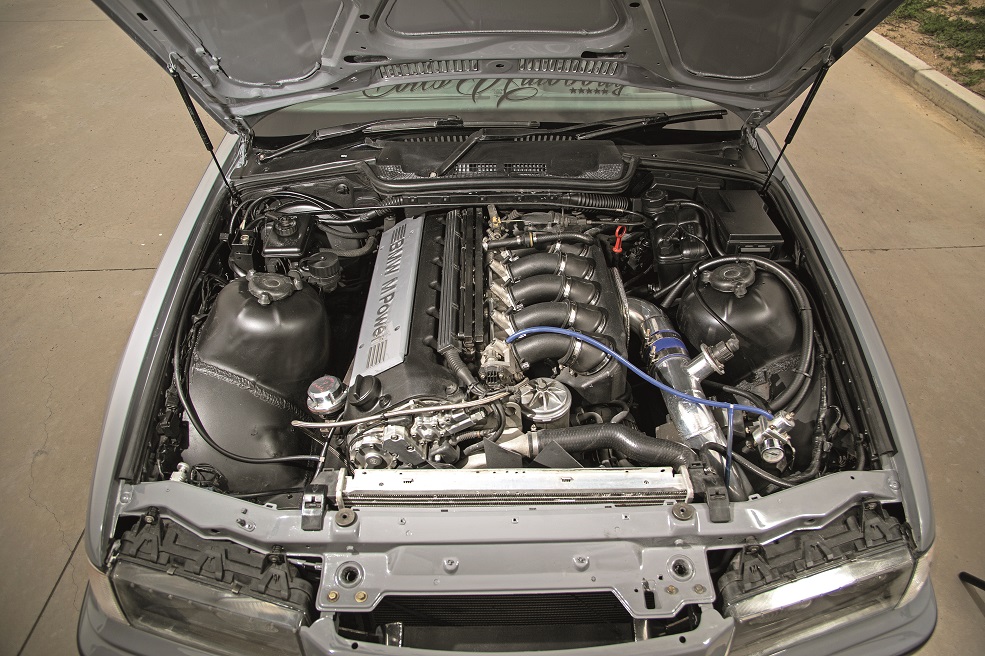
S50
History
After the E30 M3 and its storming S14, the car’s successor needed a suitably impressive engine. While the E36 M3 may have been met with a lukewarm reception upon its launch, mainly due to the massive change in direction that BMW took when developing the car, the S50B30 and its B32 successor were both incredibly impressive engines and up there with the best of the BMW M3 engines. The S50B30 arrived in 1992 and remained in use until 1995, with a different variation for North America and a couple for limited production models. The S50B32 was used in the M3 3.2 Evo from 1995 to 1999 and in the Z3 M Coupé and Roadster from 1997 to 2001.
Technical
The S50 is based on its non-M M50 counterpart, with a cast-iron block but with a large number of significant revisions. The biggest M50 engine was the 2.5 but for the S50 BMW increased bore to 86mm and stroke to 85.8mm to take capacity up to 2990cc. Compression rose to 10.8:1 and the cylinder head was ported and polished while individual throttle bodies were also fitted. Heavy-duty valve springs were added along with single-Vanos, a dual-mass flywheel, free-flowing intake and exhaust system, with Bosch Motronic M3.3 engine management looking after everything. This version of the S50B30 made 286hp at 7000rpm with 236lb ft of torque at 3600rpm. For the US-market E36 M3, BMW developed the S50B30USA; the two engines used similar blocks and shared the same capacity but that’s where the similarities ended. The B30USA used the less complex head and two-stage Vanos of the M50 as well as retaining hydraulic lifters; it missed out on the individual throttle bodies and used a lower compression ratio of 10.5:1. It developed 240hp at 6000rpm with 225lb ft of torque.
There were several special versions of the S50B30 produced. For the E36 M3 GT, the engine was fitted with 264º cams, a BMW Motorsport dual-pickup oil pan, duocentric oil pumps and upgraded Vanos software, which gave it 295hp at 7000rpm and 238lb ft of torque at 3900rpm. For the Australian-only E36 M3-R, the engine was tuned by BMW M and Schnitzer Motorsport and fitted with more aggressive cams, revised intake and exhaust ports, a lightweight flywheel and a dual-pickup oil pump. These changes resulted in 324hp at 7200rpm and 258lb ft of torque at 4400rpm.
For the S50B32, BMW introduced several revisions to improve performance. Bore and stroke were increased to 86.4mm and 91mm for a total capacity of 3201cc while the compression ratio rose to 11.3:1. Double-Vanos was introduced and lightweight pistons were fitted along with graphite-coated con rods, larger inlet valves, improved intake and exhaust systems, an improved dual-mass flywheel, secondary oil pump pickup and BMW/Siemens MSS50 engine management. This took power to 321hp at 7400rpm and torque now stood at 258lb ft at 3250rpm, with the S50B32 being the first road-going BMW engine to break the 100hp/litre barrier. For the South African market, the engine was revised slightly to be able to cope with the country’s lower octane fuel; different pistons were utilised, lowering the compression ratio to 10.5:1 and power dropped to 310hp at 7400rpm with 251lb ft of torque at 3250rpm. For the M3 Evo, the US received the S52B32, based on the M52; capacity stood at 3152cc thanks to a bore of 86.4mm and 89.6mm stroke. The engine was fitted with more finely balanced camshafts, reduced mass valve lifters, springs and spring seats and revised intake and exhaust systems. Despite these changes, power remained unchanged at 240hp at 6000rpm though torque increased to 236lb ft at 3800rpm; in cars fitted with the auto this was restricted to 225lb ft.
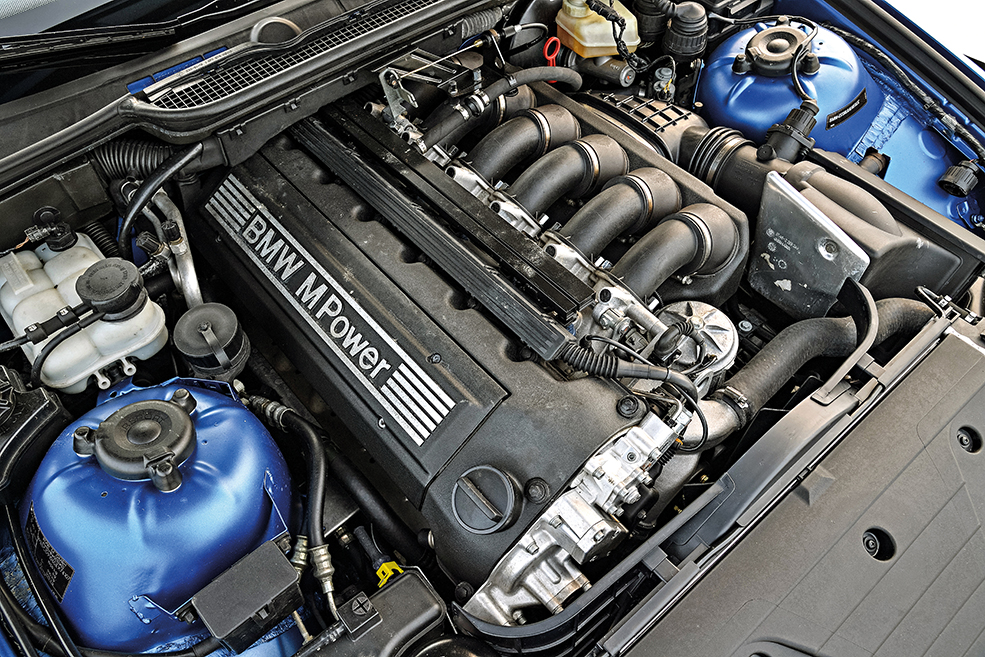
BMW M3 engines | E36 M3 tech spec:
S50B30
Capacity: 2990cc
Bore: 86mm
Stroke: 85.8mm
Compression ratio: 10.8:1
Max power: 286hp @ 7000rpm
Max torque: 236lb ft @ 3600rpm
Applications: E36 M3 3.0
S50B32
Capacity: 3201cc
Bore: 86.4mm
Stroke: 91mm
Compression ratio: 11.3:1
Max power: 321hp @ 7400rpm
Max torque: 258lb ft @ 3250rpm
Applications: E36 M3 3.2 Evo, Z3 M Roadster, Z3 M Coupé
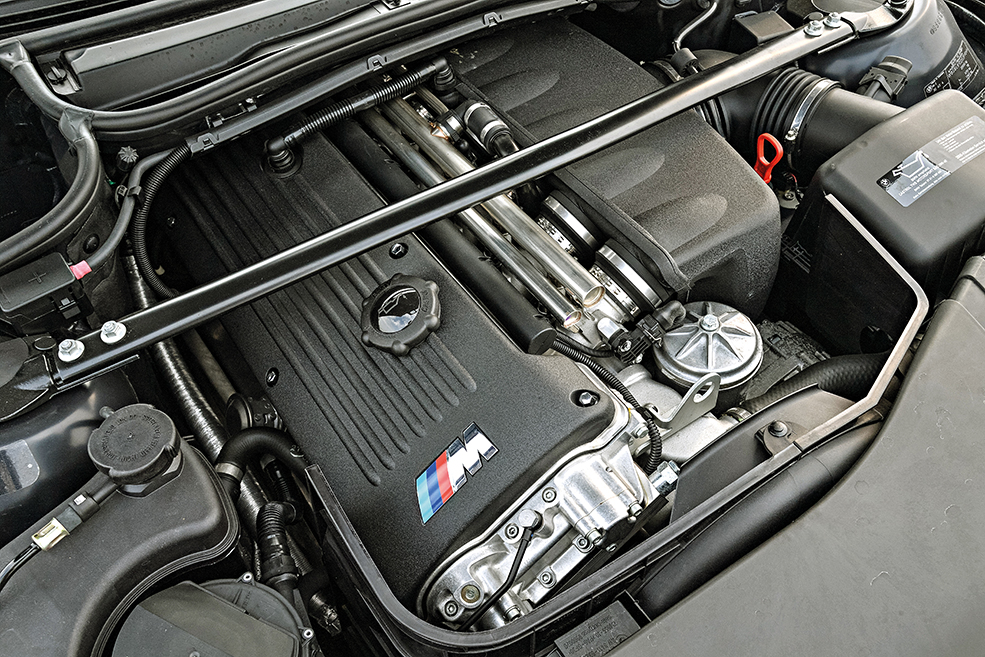
S54
History
The 3.2-litre S54 is a thrilling, high-revving, and powerful naturally aspirated straight-six which is still arguably one of BMW M3 engines. We’re not the only ones to think that the S54 is something of a masterpiece – in 2001 it took the titles of ‘Best New Engine’ and ‘Engine of the Year’ in the International Engine of the Year Awards. It won the latter award in the 3.0-4.0-litre category for six years straight, right up until it finished production in 2006. The S54 is essentially BMW’S wildest evolution of the M50 series of straight-six engines; despite the name, its closest relative is the S50 from the E36 M3, not the M54 as is often thought. The S54 was not only fitted to the E46 M3 but also featured in the late (2001-2002) Z3 M Coupé and Roadster and the Z4 M Coupé and Roadster as well.
Compared to the S50, the S54 has a slightly bigger bore, higher compression, drive-by-wire throttle control, a head with multiple improvements and changes, and a few other touches that led to a far more advanced engine. The result for European market engines is 343hp and 269lb ft of torque. The most extreme version of the S54 was found in the 2004 E46 M3 CSL; improvements included a carbon fibre air box, revised cams and a lighter exhaust, which pushed power to 360hp and 270lb ft.
Technical
The 3246cc S54 was based on the M50 architecture, and so its basic layout and structure are shared in many ways. The bore spacing is the same 91mm as was used for the M50 and M20 before it – it was, therefore, necessary to use cast iron for the block to retain enough cylinder wall strength, as a bore of 87mm leaves little meat between the bores.
The 91mm stroke is something that shows the extent of engineering that went into the S54. The normal practice when trying to give an engine high-revving characteristics is to make it oversquare (meaning the bore is bigger than the stroke). However, the S54 manages to be an engine that loves to rev while also having a long stroke, giving it a very torquey nature too.
This long stroke combined with the high-revving nature of the S54 means that piston speeds are exceptionally high and the engine has one of the highest piston speeds for any production engine at 24.25 metres per second; for reference, a 2.4-litre F1 V8 is around 25m/s. This puts a huge amount of stress on the engine’s internals so steps taken to improve bottom-end reliability include a forged crank, forged rods, oil jets to cool the graphite-lined piston skirts, and there’s also an oil scavenging pump to prevent oil starvation from occurring during hard cornering.
The head is a cast aluminium unit with double-Vanos, meaning there’s variable valve timing on both the inlet and exhaust cams. The valves are operated via finger-type rocker arms and shimmed tappets. Bolted to the intake side you’ll find six throttle butterflies, operated by a single electronic throttle actuator and each with its own velocity stack contained within the air box. The exhaust manifolds are nigh-on equal-length stainless steel for Euro models, with US versions having cats mounted within the exhaust manifolds, resulting in a 10hp and 7lb ft deficit. The Siemens MSS54 engine management system is extraordinarily capable, being as good as, if not better, than some aftermarket standalone systems and you shouldn’t underestimate its ability to control high-power setups.
The aforementioned most extreme version of the S54 was the one found in the M3 CSL. The most noticeable improvement is the carbon fibre air box, which featured a large internal panel filter and a much less restrictive design to allow greater airflow; another big plus is that it results in a very distinctive induction noise. To run this air box, which doesn’t feature a MAF sensor, the CSL engine uses a MAP (manifold absolute pressure) sensor and an appropriately reprogrammed ECU. More aggressive camshafts are the other performance change and together they result in 360hp. A lightly revised exhaust manifold made of thinner material helped to reduce weight.
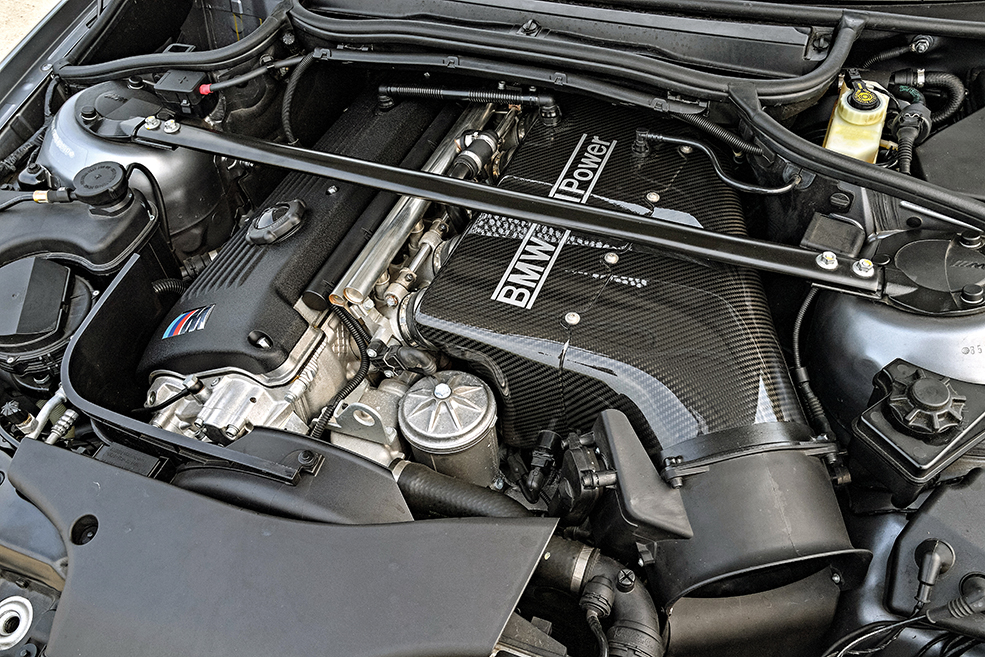
BMW M3 engines | E46 M3 tech spec:
S54B32(HP)
Capacity: 3246cc
Bore: 87mm
Stroke: 91mm
Compression ratio: 11.5:1
Max power: 343hp @ 7900rpm (360hp)
Max torque: 269lb ft @ 4900rpm (273lb ft @ 4300rpm)
Applications: E46 M3, E46 M3 CSL (HP), E36/7/8 Z3 M Roadster/Coupé, E85/6 Z4 M
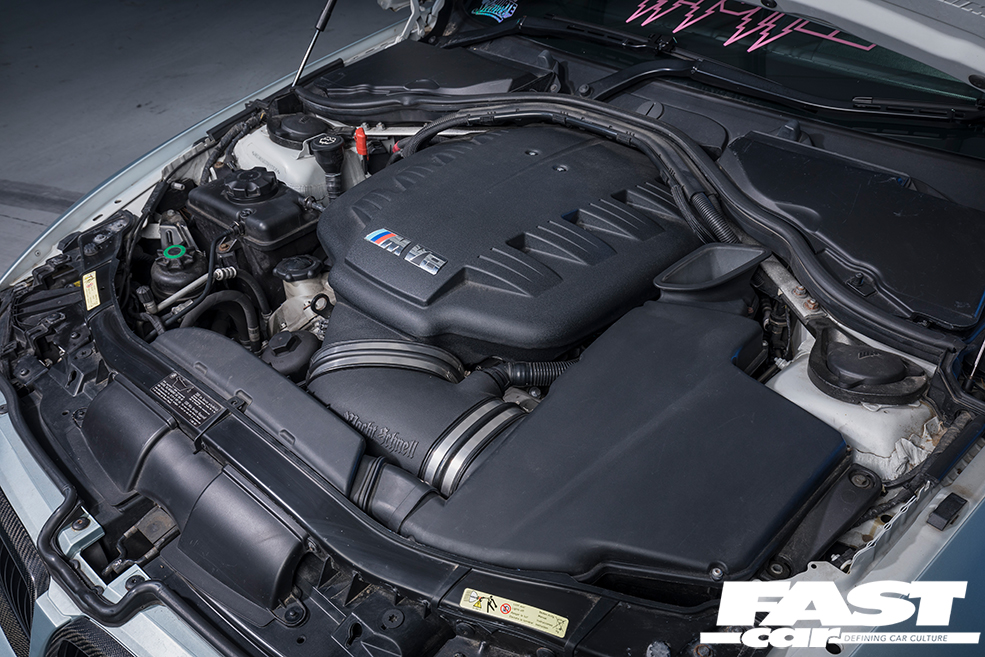
S65
History
The S65 V8 was introduced in the E9x M3 range in 2008 in 4.0-litre, 420hp form, and carried on unchanged until production finished in 2014. In 2010, BMW introduced a reworked 4.4-litre version for the limited edition E92 M3 GTS, pushing out 450hp, and this same engine was also used in the E90 M3 CRT in 2011. The S65B40 won the 3.0-4.0-litre category in the Engine of the Year awards every from 2008-2012, an impressive achievement.
Check out our top 5 BMW V8 cars you should buy.
Technical
The S65 is a 3999cc V8 built using aluminium-silicon alloy construction, which it shares with the S85 V10 from which it is derived, and it also shares some of that engine’s technology. At the time of its production, the S65 was the world’s highest-revving volume-produced V8, with a redline of 8400rpm, and at maximum revs the engine takes in 400 litres of air per second. Perhaps even more impressive was the fact that despite the increase in capacity and two additional cylinders over the S54 straight-six it replaced, at 202kg the S65 was actually 15kg lighter. In addition to that, it was also 32mm shorter than the previous engine, which might not sound like much, but it allowed the V8 to be located further back in the engine bay, helping to improve the car’s weight distribution.
As it is derived from the S85 V10, it comes as no surprise to learn that the S65 shares the same bore at 92mm and stroke at 75.2mm as its larger cousin, along with double-Vanos and the 12.0:1 compression ratio. Individual throttle butterflies for each cylinder offer improved response while the alternator disconnects from the engine during acceleration to maximise power. BMW moved from a four-pump semi-dry-sump lubrication system in the S85 to a two-pump conventional wet-sump arrangement on the S65, further decreasing weight, while still being able to deal with up to 1.4g of cornering and deceleration force.
In terms of power, the S65 develops 420hp at 8300rpm with a torque peak of 295lb ft at 3900rpm, with 251lb ft available from 2000rpm and 85% of the engine’s torque is available across a 6500rpm range, making it impressively flexible. For the S65B44 found in the GTS and, later, the CRT, BMW upped displacement to 4.4-litres by increasing the engine’s stroke to 82mm, which resulted in peak power of 450hp at 8300rpm and 325lb ft of torque at 3750rpm.
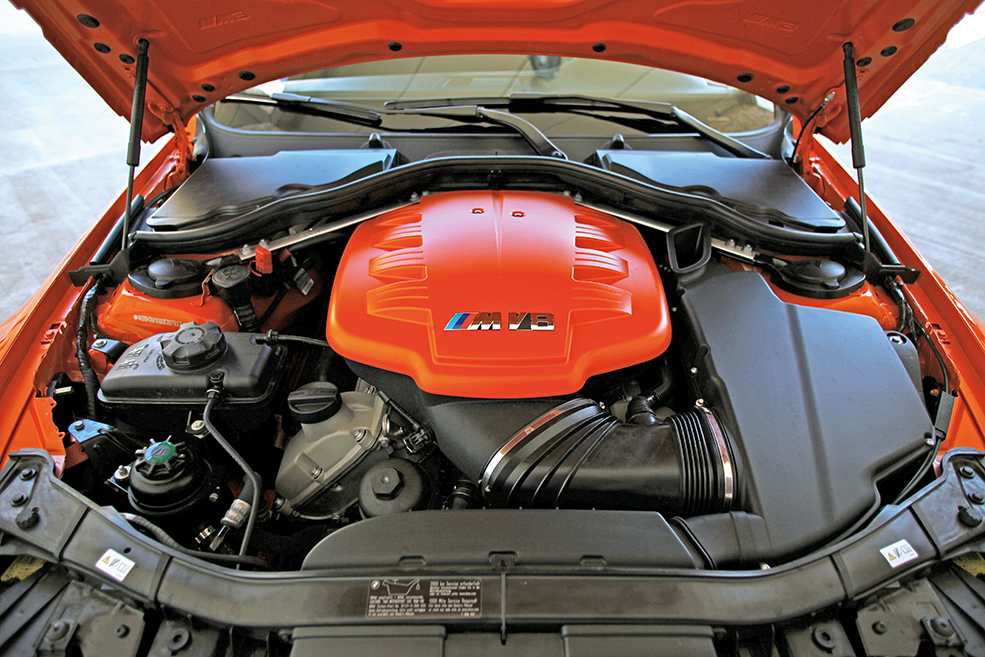
BMW M3 engines | E90/E92 M3 tech spec:
S65B40
Capacity: 3999cc
Bore: 92.0mm
Stroke: 75.2mm
Compression ratio: 12.0:1
Max power: 420hp @ 8300rpm
Max torque: 295lb ft @ 3900rpm
Applications: E9x M3
S65B44
Capacity: 4361cc
Bore: 92.0mm
Stroke: 82.0mm
Compression ratio: 12.0:1
Max power: 450hp @ 8300rpm
Max torque: 325lb ft @ 3750rpm
Applications: E92 M3 GTS, E90 M3 CRT
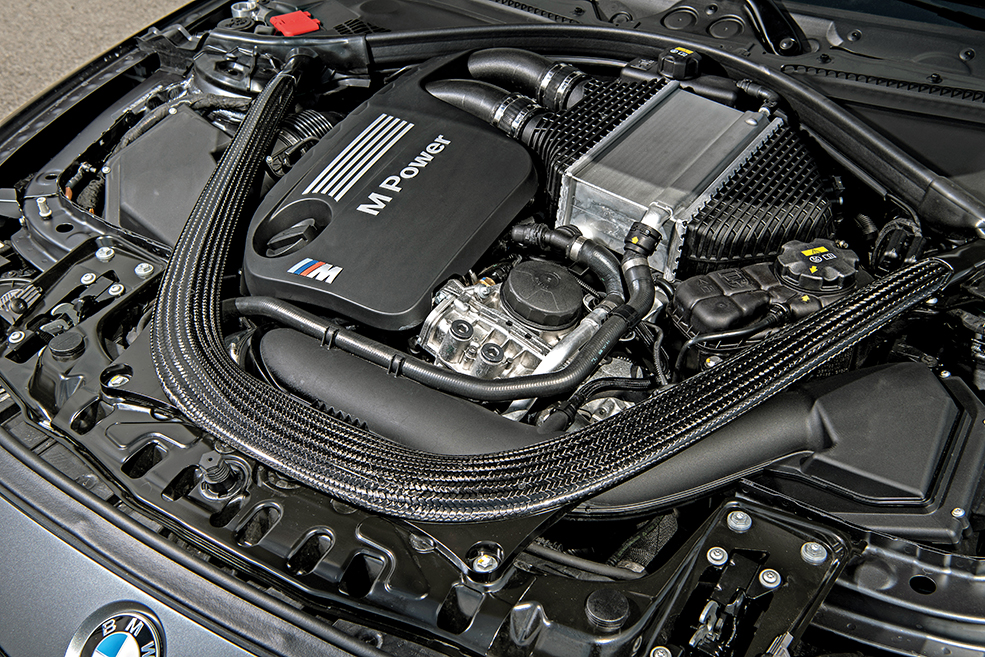
S55
History
The S55 was introduced in 2014 in both the F80 M3 and F82 M4 models and is based on the single-turbo N55, albeit with a raft of changes on board. Since its launch, it has found its way into the F87 M2 Competition in a slightly de-tuned form, and in slightly higher states of tune in the Competition and CS versions of the M3 and M4, with the hottest version fitted in the M4 GTS.
Technical
The S55 was based on the N55 and utilised 75% of that engine’s components while the remaining 25% were developed specifically for the S55. At 84mm and 89.6mm, the bore and stroke are the same as those of the non-M engine giving the S55 the same capacity. BMW M chose to employ twin-turbos as in the earlier N54, as opposed to the single-turbo arrangement of the N55, and they are unique to the S55, with a lightweight design and electronic wastegates. The S55 makes just 11hp more than the S65 it replaced, though this is produced much lower down the rev range, between 5500-7300rpm, making it more accessible. The move to forced induction did mean that the S55 is rather better endowed than the S65 in the torque department – where the naturally aspirated V8 had to make do with 295lb ft, the same as the N55, the twin-turbo S55 develops a meaty 406lb ft from 1850-5500rpm, giving it some monster mid-range punch. The engine also employs direct injection, Valvetronic, double-Vanos and uses a closed-deck crankcase design, which increases rigidity and allows cylinder pressure to be increased for maximum power. Instead of cylinder liners, the cylinder bores of the S55 feature a twin wire arc-sprayed coating, which helps to reduce engine weight and there’s a forged, torsionally-rigid crankshaft, which increases torque-carrying capacity and is also lighter and its reduced rotating mass improves throttle response and acceleration.
The S55 features a high-performance cooling system, with a large chargecooler and additional radiators for the water circuits, turbocharger and transmission oil while an electric coolant pump cools the turbos when you turn the engine off. The S55 also employs a lightweight magnesium sump that features a special cover to limit the movement of the oil under extreme cornering, and during heavy acceleration and deceleration an oil extraction pump and sophisticated oil return system located close to the turbocharger help to maintain uninterrupted oil circulation. The exhaust system uses an electronically controlled flap arrangement located just before the rear silencer that reduces back pressure. The increase in power for both the Competition and CS versions of the M3 and M4 comes courtesy of a software revision, but for the M4 GTS, BMW added water injection, which in turn allowed boost pressure to be increased from 1.19 to 1.49 bar thus making more power.
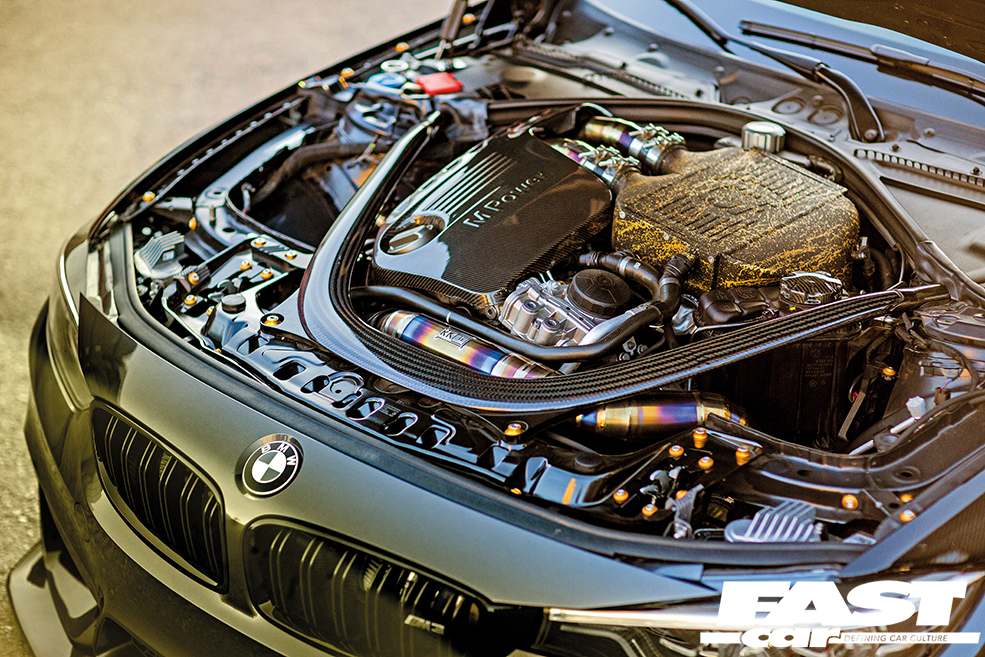
BMW M3 engines | F80 M3 tech spec:
S55B30
Capacity: 2979cc
Bore: 84mm
Stroke: 89.6mm
Compression ratio: 10.2:1
Max power: 431hp @ 5500-7300rpm
Max torque: 406lb ft @ 1850-5500rpm (443lb ft)
Applications: F8x M3/4, F87 M2 Competition (410hp), F8x M3/4 Competition (450hp), F8x M3/4 CS (460hp), F82 M4 GTS (500hp)
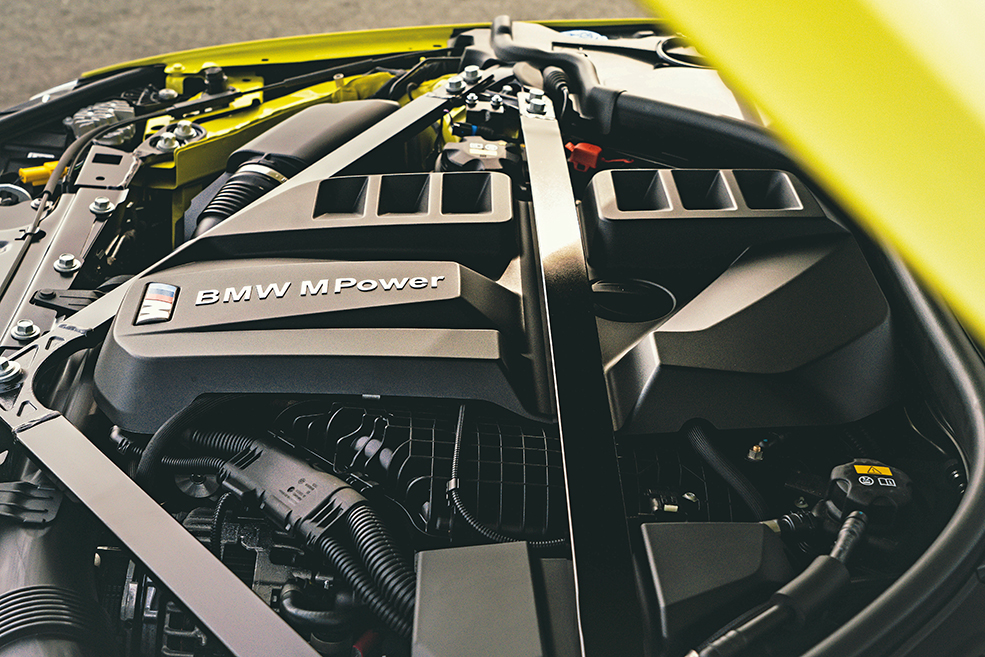
S58
History
The S58 replaced the S55 and, much like its predecessor, is based on its non-M variant, in this case the single-turbo straight-six B58. The S58 made its debut in the F97 X3 M and F98 X4 M in 2019 in 480hp form and in its 510hp incarnation for the Competition models before then being fitted to the G8x M3 and M4 in 2021.
Technical
The S58 uses a sleeve-free closed-deck design which results in an extremely rigid crankcase, and this allows for higher compression, while a wire-arc sprayed iron coating for the cylinder walls reduces frictional losses and weight. The S58 uses a lightweight forged crankshaft and this reduction in rotating mass results in the engine being able to rev more freely and the crankshaft drive has exceptional torsional resistance, allowing it to better cope with higher power and torque outputs. The cylinder head, meanwhile, has a core manufactured using 3D printing – this process enables geometric forms to be created that are beyond the capability of conventional metal casting techniques and not only is the core lighter but it has also allowed the coolant ducts to be routed in a way that optimises temperature management.
The S58 uses two mono-scroll turbos along with an indirect intercooler supplied by a low-temperature circuit and special compressors, which optimise the power output of the turbos. Its electronically controlled wastegate helps to increase turbo response while a flow-optimised design reduces the pressure losses in the dual-flow air intake system. The engine uses the latest high-precision injection system which sends fuel into the combustion chambers at a maximum pressure of 350 bar; this enables shorter injection times and results in a more efficient mixture preparation. The S58 also incorporates Valvetronic variable valve timing and double-Vanos variable camshaft timing.
Efficient cooling is essential for a high-performance engine like the S58 and while the G8x’s nose might have come in for controversy, all those huge intakes ensure that the engine gets plenty of air. In the central area behind the kidney grille, the air first encounters the low-temperature radiator and then the high-temperature radiator. In the lower area, the airflow is also fed through the horizontally arranged engine oil cooler and – in the Competition models – through a separate transmission oil cooler. At low speeds and when there is a greater need for cooling, an electrically powered fan lends a helping hand.
An electric coolant pump in the low-temperature system helps to optimise volume flow for the intercooler. The high-temperature circuit comprises a mechanical water pump, the main radiator and two remote ones to the sides in the wheel arches. Together, these elements supply coolant to the engine block and the two turbochargers. An additional electric water pump allows turbocharger cooling to continue for a certain length of time once the engine has been switched off. Finally, the oil supply system has been designed with track driving in mind. The engine’s weight-minimised sump has two separate chambers and an integrated suction channel; an additional suction stage allows the map-controlled oil pump to draw lubricant from the smaller chamber, which steps in when extra capacity is needed. This ensures the S58 gets a reliable supply of oil at all times, even under extreme cornering and acceleration.
The S58 makes 480hp at 6250rpm with its 405lb ft torque peak available from 2650-6130rpm while the version found in Competition models makes 510hp also at 6250rpm while its torque peak of 479lb ft spreads from 2750-5500rpm; the S58’s redline is at 7200rpm.
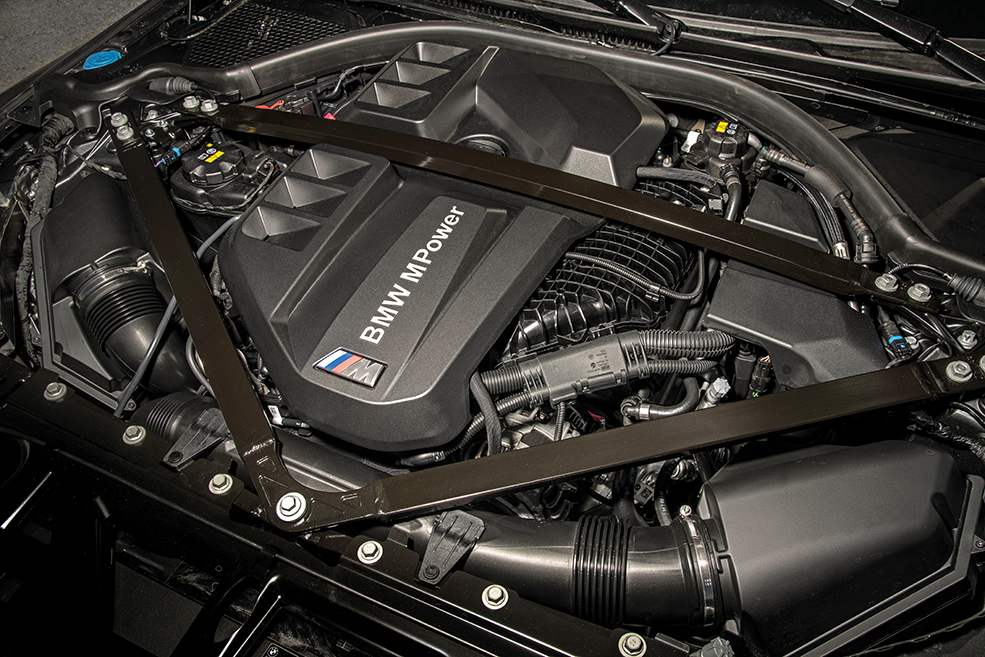
BMW M3 engines | G80 M3 tech spec:
S58B30T0
Capacity: 2993cc
Bore: 84mm
Stroke: 90mm
Compression ratio: 9.3:1
Max power: 480hp @ 6250rpm (510hp)
Max torque: 405lb ft @ 2650-6130rpm (479lb ft @ 2750-5500rpm)
Applications: F97/8 X3/4 M and Competition, G8x M3/4 and Competition

